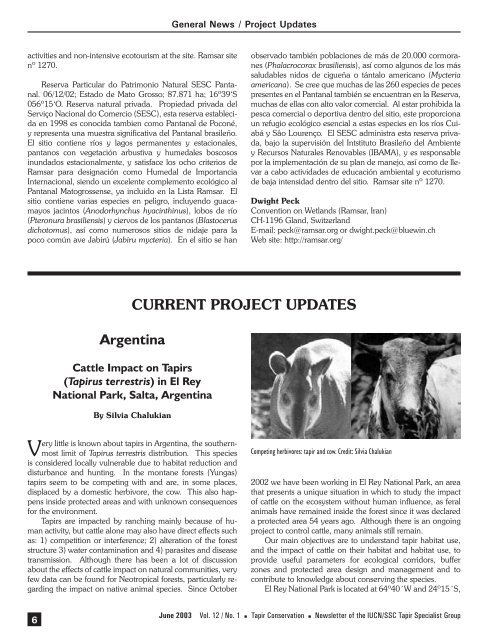Download now - Tapir Specialist Group
Download now - Tapir Specialist Group
Download now - Tapir Specialist Group
You also want an ePaper? Increase the reach of your titles
YUMPU automatically turns print PDFs into web optimized ePapers that Google loves.
activities and non-intensive ecotourism at the site. Ramsar site<br />
nº 1270.<br />
Reserva Particular do Patrimonio Natural SESC Pantanal.<br />
06/12/02; Estado de Mato Grosso; 87.871 ha; 16º39‘S<br />
056º15‘O. Reserva natural privada. Propiedad privada del<br />
Serviço Nacional do Comercio (SESC), esta reserva establecida<br />
en 1998 es conocida tambien como Pantanal de Poconé,<br />
y representa una muestra significativa del Pantanal brasileño.<br />
El sitio contiene ríos y lagos permanentes y estacionales,<br />
pantanos con vegetación arbustiva y humedales boscosos<br />
inundados estacionalmente, y satisface los ocho criterios de<br />
Ramsar para designación como Humedal de Importancia<br />
Internacional, siendo un excelente complemento ecológico al<br />
Pantanal Matogrossense, ya incluido en la Lista Ramsar. El<br />
sitio contiene varias especies en peligro, incluyendo guacamayos<br />
jacintos (Anodorhynchus hyacinthinus), lobos de río<br />
(Pteronura brasiliensis) y ciervos de los pantanos (Blastocerus<br />
dichotomus), así como numerosos sitios de nidaje para la<br />
poco común ave Jabirú (Jabiru mycteria). En el sitio se han<br />
observado también poblaciones de más de 20.000 cormoranes<br />
(Phalacrocorax brasiliensis), así como algunos de los más<br />
saludables nidos de cigueña o tántalo americano (Mycteria<br />
americana). Se cree que muchas de las 260 especies de peces<br />
presentes en el Pantanal también se encuentran en la Reserva,<br />
muchas de ellas con alto valor comercial. Al estar prohibida la<br />
pesca comercial o deportiva dentro del sitio, este proporciona<br />
un refugio ecológico esencial a estas especies en los ríos Cuiabá<br />
y Sâo Lourenço. El SESC administra esta reserva privada,<br />
bajo la supervisión del Intstituto Brasileño del Ambiente<br />
y Recursos Naturales Renovables (IBAMA), y es responsable<br />
por la implementación de su plan de manejo, así como de llevar<br />
a cabo actividades de educación ambiental y ecoturismo<br />
de baja intensidad dentro del sitio. Ramsar site nº 1270.<br />
Dwight Peck<br />
Convention on Wetlands (Ramsar, Iran)<br />
CH-1196 Gland, Switzerland<br />
E-mail: peck@ramsar.org or dwight.peck@bluewin.ch<br />
Web site: http://ramsar.org/<br />
CURRENT PROJECT UPDATES<br />
Argentina<br />
Cattle Impact on <strong>Tapir</strong>s<br />
(<strong>Tapir</strong>us terrestris) in El Rey<br />
National Park, Salta, Argentina<br />
By Silvia Chalukian<br />
Very little is k<strong>now</strong>n about tapirs in Argentina, the southernmost<br />
limit of <strong>Tapir</strong>us terrestris distribution. This species<br />
is considered locally vulnerable due to habitat reduction and<br />
disturbance and hunting. In the montane forests (Yungas)<br />
tapirs seem to be competing with and are, in some places,<br />
displaced by a domestic herbivore, the cow. This also happens<br />
inside protected areas and with unk<strong>now</strong>n consequences<br />
for the environment.<br />
<strong>Tapir</strong>s are impacted by ranching mainly because of human<br />
activity, but cattle alone may also have direct effects such<br />
as: 1) competition or interference; 2) alteration of the forest<br />
structure 3) water contamination and 4) parasites and disease<br />
transmission. Although there has been a lot of discussion<br />
about the effects of cattle impact on natural communities, very<br />
few data can be found for Neotropical forests, particularly regarding<br />
the impact on native animal species. Since October<br />
6<br />
General News / Project Updates<br />
Competing herbivores: tapir and cow. Credit: Silvia Chalukian<br />
2002 we have been working in El Rey National Park, an area<br />
that presents a unique situation in which to study the impact<br />
of cattle on the ecosystem without human influence, as feral<br />
animals have remained inside the forest since it was declared<br />
a protected area 54 years ago. Although there is an ongoing<br />
project to control cattle, many animals still remain.<br />
Our main objectives are to understand tapir habitat use,<br />
and the impact of cattle on their habitat and habitat use, to<br />
provide useful parameters for ecological corridors, buffer<br />
zones and protected area design and management and to<br />
contribute to k<strong>now</strong>ledge about conserving the species.<br />
El Rey National Park is located at 64º40´W and 24º15´S,<br />
June 2003 Vol. 12 / No. 1 n <strong>Tapir</strong> Conservation n Newsletter of the IUCN/SSC <strong>Tapir</strong> <strong>Specialist</strong> <strong>Group</strong>










